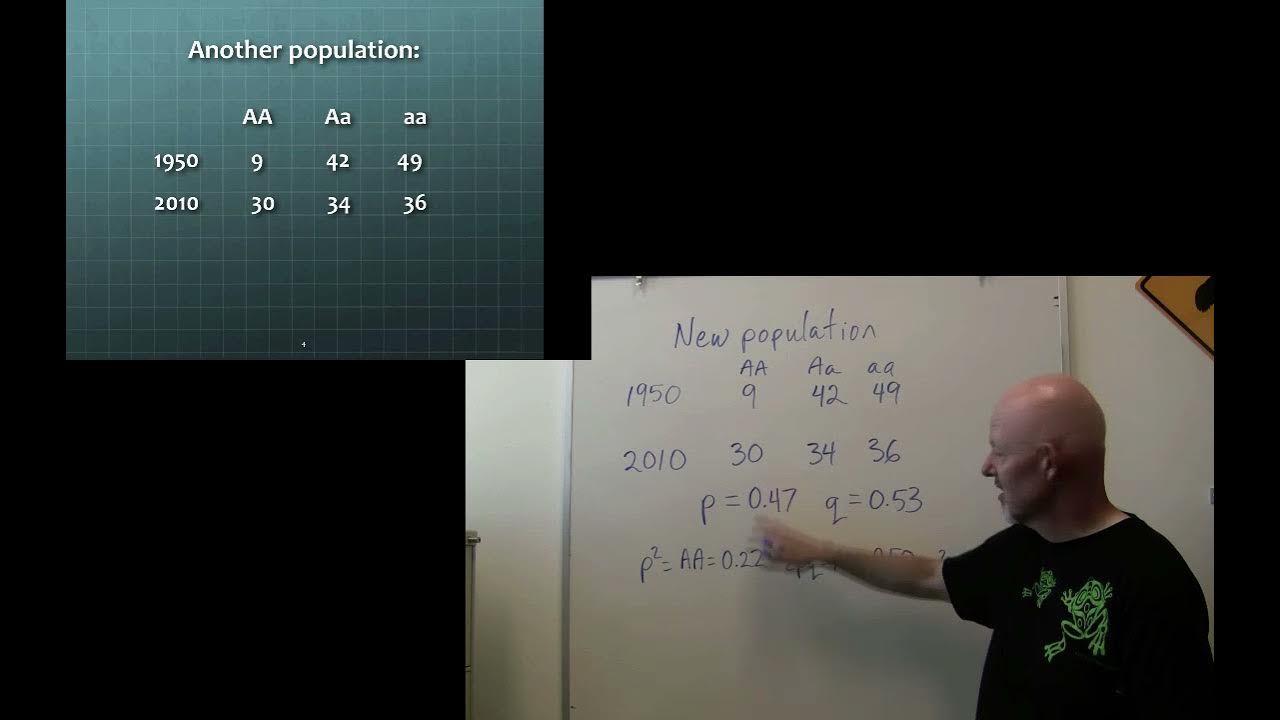Genetics Step 1 — Hardy-Weinberg Law — Boards and Beyond
Summary
TLDRThe Hardy-Weinberg law is a fundamental principle used to study population genetics, predicting allele and genotype frequencies in a population under specific conditions. The law helps calculate the likelihood of different gene combinations based on known allele frequencies. Assumptions include large population size, random mating, no mutations, no migration, and no natural selection. The principle is useful in studying recessive genetic diseases, as it allows the determination of carrier frequencies. Special considerations apply to X-linked recessive diseases, where males and females are treated as separate populations with different genotypic calculations.
Takeaways
- 🧬 The Hardy-Weinberg Law (or Principle) is used in population genetics to calculate genotype frequencies from known allele frequencies.
- 👩👩👧 Each person has two copies of every gene—one from each parent—and these copies may be identical or different depending on the alleles present.
- 🔤 An allele is one of two or more alternative forms of a single gene; the law applies only to single genes with multiple alleles, not across different loci or chromosomes.
- ⚖️ For a gene with two alleles, the sum of their frequencies equals one (p + q = 1), where p and q represent the frequencies of the two alleles.
- 📊 The Hardy-Weinberg equation (p² + 2pq + q² = 1) describes genotype frequencies: p² for homozygous dominant, 2pq for heterozygous, and q² for homozygous recessive individuals.
- 🔍 Example: If p = 0.4 and q = 0.6, then genotype frequencies are 16% AA, 48% Aa, and 36% aa, which together sum to 100%.
- 📏 The law assumes five key conditions: a large population, random mating, no mutations, no migration, and no natural selection.
- 🧩 When these assumptions are met, allele frequencies remain constant from generation to generation—this state is known as Hardy-Weinberg equilibrium.
- 🧫 The principle helps estimate carrier frequencies for autosomal recessive diseases by using the observed frequency of affected individuals (q²) to calculate q, then deriving carrier frequency as 2pq.
- 💡 For very rare diseases, p is approximately 1, allowing simplification of carrier frequency calculations to roughly 2q.
- 🚻 In X-linked recessive diseases, males and females are analyzed separately: for males, p and q directly represent the frequencies of healthy and diseased individuals; for females, Hardy-Weinberg equations are applied to determine healthy, carrier, and affected genotype frequencies.
- 🎯 Overall, the Hardy-Weinberg Law provides a mathematical framework to predict genetic variation in populations under ideal conditions and serves as a foundation for understanding genetic stability and evolution.
Q & A
What is the Hardy-Weinberg law used for?
-The Hardy-Weinberg law is used to study populations and determine the genotype frequencies based on allele frequencies. It helps calculate how likely different alleles will occur together in individuals within a population.
What are alleles, and how do they relate to the Hardy-Weinberg law?
-Alleles are alternative forms of a gene. The Hardy-Weinberg law applies to genes with two or more alleles, and it is used to calculate the frequency of these alleles and how they combine in a population.
What is the Hardy-Weinberg equation, and what does each part represent?
-The Hardy-Weinberg equation is p² + 2pq + q² = 1, where p is the frequency of the dominant allele, q is the frequency of the recessive allele, p² is the frequency of individuals with two dominant alleles, 2pq is the frequency of heterozygotes, and q² is the frequency of individuals with two recessive alleles.
What do p and q represent in the Hardy-Weinberg law?
-In the Hardy-Weinberg law, p represents the frequency of the dominant allele, and q represents the frequency of the recessive allele in the population.
What assumption about populations is required for the Hardy-Weinberg law to apply?
-For the Hardy-Weinberg law to apply, the population must be large, have random mating, no gene mutations, no migration, and no natural selection. These assumptions ensure that allele frequencies remain constant across generations.
How can the Hardy-Weinberg law be applied to autosomal recessive diseases?
-The Hardy-Weinberg law can be used to estimate the carrier frequency of autosomal recessive diseases. By knowing the frequency of individuals with the disease (q²), we can calculate the frequency of carriers (2pq) in the population.
How do you calculate the carrier frequency for a recessive disease using the Hardy-Weinberg law?
-To calculate the carrier frequency for a recessive disease, first find q² (the frequency of individuals with the disease), then calculate q by taking the square root of q². Use p = 1 - q, then multiply 2 * p * q to find the carrier frequency.
What does it mean if a population is in Hardy-Weinberg equilibrium?
-A population is in Hardy-Weinberg equilibrium if allele frequencies do not change from one generation to the next, meaning that the population meets all the necessary assumptions of the Hardy-Weinberg law.
Why is the Hardy-Weinberg law useful in studying rare diseases?
-The Hardy-Weinberg law is useful for studying rare diseases because it allows researchers to estimate carrier frequencies. By knowing the frequency of affected individuals, we can calculate how many people are carriers of a recessive disease, which may not be immediately apparent.
What is the significance of X-linked recessive diseases in the context of Hardy-Weinberg equilibrium?
-X-linked recessive diseases require special consideration in Hardy-Weinberg equilibrium because males and females have different genotypic possibilities due to the sex chromosomes. The law can be applied separately to males and females to calculate the frequencies of affected and carrier individuals.
Outlines

此内容仅限付费用户访问。 请升级后访问。
立即升级Mindmap

此内容仅限付费用户访问。 请升级后访问。
立即升级Keywords

此内容仅限付费用户访问。 请升级后访问。
立即升级Highlights

此内容仅限付费用户访问。 请升级后访问。
立即升级Transcripts

此内容仅限付费用户访问。 请升级后访问。
立即升级5.0 / 5 (0 votes)






